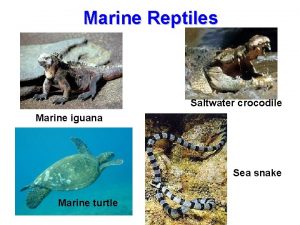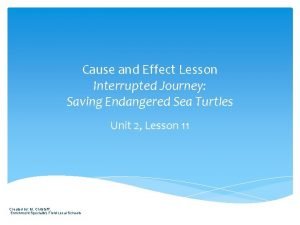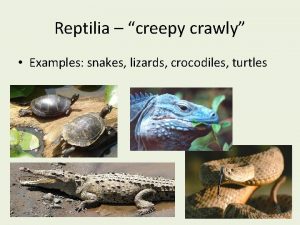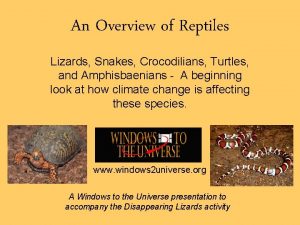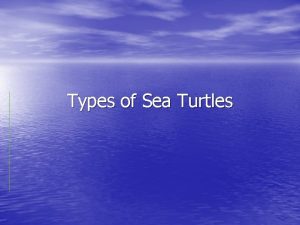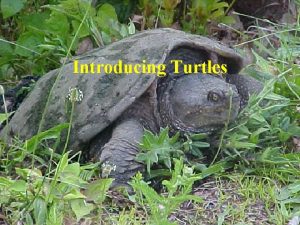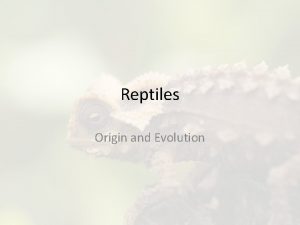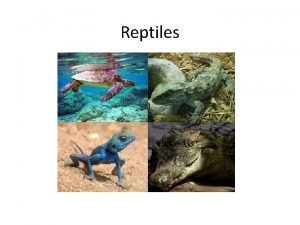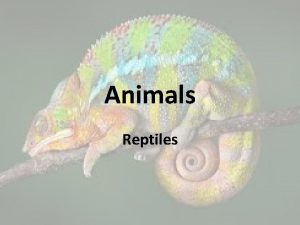An Overview of Reptiles Lizards Snakes Crocodilians Turtles














- Slides: 14

An Overview of Reptiles Lizards, Snakes, Crocodilians, Turtles, and Amphisbaenians - A beginning look at how climate change is affecting these species. www. windows 2 universe. org A Windows to the Universe presentation to accompany the Disappearing Lizards activity

Changing Planet: Disappearing Lizards NBC Learn Video – Disappearing Lizards www. windows 2 universe. org

The Diverse Reptile Family Includes: • • • An Iguana, a lizard, has 4 legs. Lizards Snakes Crocodilians Turtles Amphisbaenia (worm lizards) Tuatara A worm lizard with no legs. How are the distinct? How are they the same? www. windows 2 universe. org

Where Do Reptiles Live? Green sea turtles live in the ocean while snapping turtles live in freshwater lakes, canals and ponds. Most snapping turtles do not live on iphones (this is simply to show the baby’s size!). • They are found on every continent except Antarctica. • Reptiles can be found in the African savannah (ex: black mamba) to the rainforests of the Amazon (ex: green anaconda), urban areas (ex: geckos) to the coral reefs of the ocean (ex: sea turtles). www. windows 2 universe. org

Interesting Reptile Facts • • Largest living reptile is the saltwater crocodile -- 2, 000 kg (4, 400 lb) and 7 m (23 ft) long! The most massive snake is the green anaconda of South America -- 5. 21 m (18 ft) and 250 kg (550 lb)! The reticulated python of Asia can be over 10 feet longer, but is usually much lighter than the anaconda. The most venomous snakes in the world are actually found in the ocean (Belcher's Sea Snake) and a few milligrams of its venom would be enough to kill 1, 000 people. There are some places in the world outside the poles where snakes are not found - e. g. , Ireland New Zealand! I guess these islands are just too far to swim to! Meanwhile, people are trying to control invasive species like Burmese Pythons that have proliferated in the Everglades, with over 300 being removed each year since 2008. The Green Anole lizard has recently become the first reptile to have its complete genome sequenced. Snakes have some unlikely predators - hedgehogs, mongooses, peacocks, and even some insects like aquatic beetles and praying mantises have been known to snack on a snake or or its eggs at times!

Reptiles are Vertebrates All reptiles have a backbone. They share this trait with mammals, birds, amphibians and fishes. The American Museum of Natural History, where this photo was taken, is a great place to learn about reptiles! www. windows 2 universe. org As you can see in this photo of a snake skeleton and crocodile skull, reptiles can have many more bony features than just a backbone!

Reptile Reproduction • Some lay eggs and some bear live young. Some reptiles rear their young for a time. • Finding this Massasauga Rattlesnake alone in Michigan woods might be a daunting find! It makes the species seem a lot less intimidating (and much more maternal!) to see that this mom has her tiny babies basking in the sun with her near their den. www. windows 2 universe. org

The Difference Between Reptiles and Amphibians newt salamander • Amphibians include newts and salamanders, frogs and toads, and caecilians. They are vertebrates and they are ectothermic like reptiles. • One major difference from amphibians is that reptiles don’t undergo metamorphosis - i. e. , baby lizards look like their parents, only smaller. All reptiles breathe with their lungs. • Some reptiles live where it is dry, but some much prefer aquatic environments like alligators, turtles, marine iguanas and sea snakes.

Reptiles are Ectothermic is the scientific name for “cold-blooded” which means reptiles control their body's temperature using external means like basking in the sun or lying on a dark surface to get warmer, or seeking shade or water to cool down. www. windows 2 universe. org

Reptiles Are Being Affected by Climate Change • Climate change affects many reptiles because rising temperatures mean these animals must retreat to shade to find their perfect body temperatures. • So they have less time to forage for food and find a mate for reproduction. • Global lizard populations are dying at such a fast rate, that many scientists think lizards do not have enough time to adapt to the changes in the warming climate. Global maps of observed local extinctions in 2009, and projections for 2050 and 2080 based on geographic distributions of lizard families of the world. Data – Dr. Barry Sinervo. www. windows 2 universe. org

Specifics about Alligator Lizards • Can be up to foot long and have powerful jaws (thus their name). • Are found in Americas, Europe, Asia, Africa - making it a model animal to study. • Have folds on sides can hold live young, eggs, or food! • Can detach its tail as defense tactic (the writhing tail distracts predator while tailless lizard runs away). Can regenerate tail! • Have been found missing in Mexico where reproduction has shut down due to increasing temperatures. • The loss of these lizards can truly impact entire ecosystems, especially up and down the food chain. www. windows 2 universe. org

Why Protect Reptiles? • If reptiles disappear from an ecosystem, this obviously affects all of the predators (like other reptiles or birds or mammals) that feed on them. • It affects the prey the reptiles would catch like insects or rodents (leaving these populations unchecked). • Climate change is affecting a vital link in our ecosystems! Reptiles and amphibians (like the top photo) can be a source of wonder and amazement for children and adults alike. All species, no matter how “creepy crawly” should be protected.

Reptile Defenses • • This ringneck snake coiled up showing its bright colored belly, warning predators to stay away! This garter snake, flattened itself to make itself look as threatening as possible. It is not venomous, but it can bite! • Remember some basic reptile safety - it is best to leave any wild animal alone if you happen to stumble across it. Many reptiles are very docile and are not looking to harm humans (or their pets), but if they feel threatened, they can make loud noises, bite, musk, pee or poop to defend themselves. Some reptiles are venomous. Others are not. It can be hard to tell the difference! Copperheads are venomous. They are experts in the camouflage department. They are very docile, but might strike if stepped on.

Reptile Safety and Handling • It's best to leave handling of reptiles to the experts and touch and experience these beautiful creatures in the safe environments of zoos, wildlife preserves or nature centers. Herpetology, or the study of reptiles and amphibians, can begin at a very early age. Education, of course, is one of the best ways to show people beauty and value where once there was misunderstanding and fear.
 Freshwater lizards
Freshwater lizards Turtles
Turtles Ninja turtles personality types
Ninja turtles personality types Remember
Remember Cnidaria class
Cnidaria class Turtles
Turtles Types of turtles in south carolina
Types of turtles in south carolina Sea turtle cause and effect
Sea turtle cause and effect Turtles sonde
Turtles sonde Reptile circulatory system
Reptile circulatory system Rhodes island snakes
Rhodes island snakes Snakes in suits review
Snakes in suits review Lake erie water snake bite
Lake erie water snake bite Creepy snakes
Creepy snakes Animals in a temperate deciduous forest
Animals in a temperate deciduous forest
